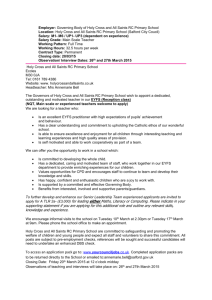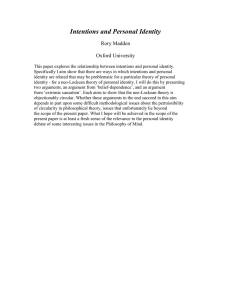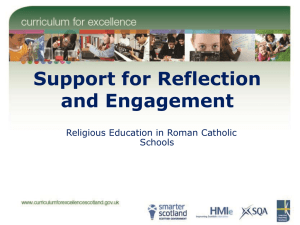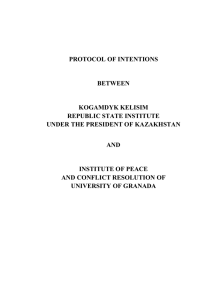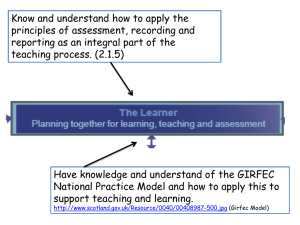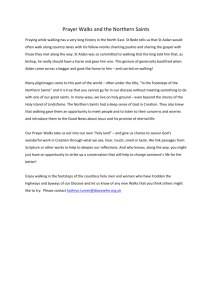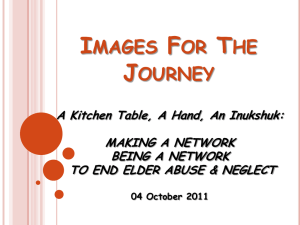Planning for Learning, Teaching and Assessment in RERC for assessment in RERC
advertisement
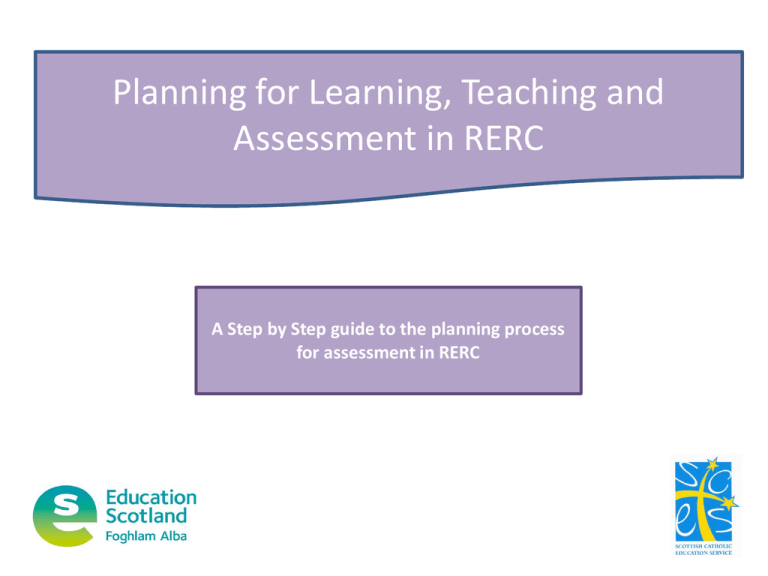
Planning for Learning, Teaching and Assessment in RERC A Step by Step guide to the planning process for assessment in RERC PLANNING FOR LEARNING TEACHING AND ASSESSMENT IN RERC This presentation complements the document; “Planning for Learning, Teaching and Assessment in RERC”. The slides show a step by step guide to planning Religious Education. The number for each step in this slide show relate directly to the 7 stages of planning as illustrated in the flow chart on page 11 of the document. 1 Plan using the Core Learning from TIOF 2 From the Core Learning Identify which E&Os will be the focus of learning 3 Using the Core Learning Identify the key words from E&O for assessment 4 Use these key words to formulate Learning Intentions 5 Use these key words from your Learning Intentions to write Success Criteria 6 Use your Success Criteria to plan the methodology for your lessons and to identify the assessment points. 7 Use TIOF to plan next steps within and across levels PLANNING FOR LEARNING TEACHING AND ASSESSMENT IN RERC The presentation is intended to aid staff development in planning and could be used to structure a CPD event / workshop / departmental planning. The slides systematically work through how to plan for learning, teaching and assessment for RERC using the example of ‘ The Communion of Saints’. The planning process outlined can be applied to any learning experiences within RERC. (i.e. Not just to classroom experiences or core R.E.) In order to use the presentation, it may be beneficial to work through the slides once, reading the content, considering the process and discussing the steps with others. Then, at an appropriate time, revisit each slide again, but the second time apply the steps to the planning of a unit/theme/topic for your own school. All planning for Learning, Teaching and Assessment for RERC should begin with the core learning from This Is Our Faith for your stage. “Catholic schools aim to help all students to develop their fullest By planning, using potential, preparing themthe for core life, learning, with stage informing their minds and forming their characters that they can partners andsoacross levels contribute and that above teacherswith canothers, be sure all with God,experiences to the transformation learning of the world.” progress at a level of This Is Our Faith challenge appropriate for each pupil at each stage. Decide on the Theme, Topic, Unit for development. This will usually, but not necessarily, be connected to the Liturgical Year COMMUNION OF SAINTS AND HOLY SOULS Theme/ Topic/Unit 1) Look at TIOF to identify the core learning for the theme/topic/unit that you are teaching. Theme/ Topic/Unit 1) Identify Core Learning COMMUNION OF SAINTS AND HOLY SOULS I have explored the ways in which we need other people in order to develop both in body and in spirit (CCC 1936) I am developing my understanding of how to use my body, mind and soul in the hope of achieving eternal happiness with God. I can describe my personal response to how this learning should have an effect on a Christian’s life and action. Through research or by learning from appropriate witnesses, I have explored and evaluated how the Saints and holy men and women have ‘heard’ God in the past and do so today. I have had the opportunity to explore what is meant by “pilgrimage” and to consider the place of prayer in pilgrimage. I have developed an understanding of the Church as a “pilgrim people”. I have responded to opportunities to participate in personal prayer, the preparation and celebration of a Class/Year Mass and/or liturgical services e.g., on the theme of community. I can describe how these can strengthen my faith. 2) By grouping the core learning from various strands together you will be able to ‘bundle’ the Experiences and Outcomes that will be used and identify what the focus for learning and assessment should be. Theme/ Topic/Unit 1) Identify Core Learning COMMUNION OF SAINTS AND HOLY SOULS I have explored the ways in which we need other people in order to develop both in body and in spirit (CCC 1936) I am developing my understanding of how to use my body, mind and soul in the hope of achieving eternal happiness with God. I can describe my personal response to how this learning should have an effect on a Christian’s life and action. RERC 3-02a Through research or by learning from appropriate witnesses, I have explored and evaluated how the Saints and holy men and women have ‘heard’ God in the past and do so today. RERC 3-12a I have had the opportunity to explore what is meant by “pilgrimage” and to consider the place of prayer in pilgrimage. I have developed an understanding of the Church as a “pilgrim people”. I have responded to opportunities to participate in personal prayer, the preparation and celebration of a Class/Year Mass and/or liturgical services e.g., on the theme of community. I can describe how these can strengthen my faith. RERC 3-14a 2) Bundle Experiences and Outcomes RERC3-14a I have considered the Christian vision of the dignity of the human person, made in the image and likeness of God. I have reflected upon how this has contributed to my becoming the person I am today. RERC3-12a LIT I can describe what I believe Biblical texts say about the way that God spoke to people in the past and how God speaks to people today I recognise the importance of personal prayer and communal prayer in the growth of all people’s relationship with God. I know a number of traditional Catholic prayers and I have developed an understanding of the meaning of these prayers. I have participated in different approaches to, and experiences, of prayer. I can describe how prayer is an important part of the liturgical and devotional life of the Church. I have reflected on how all of these are different ways of worshipping God. COMMUNION OF SAINTS AND HOLY SOULS UNIT I can use notes and other types of writing to generate and develop ideas, retain and recall information, explore problems, make decisions, generate and develop ideas or create original text. I recognise when it is appropriate to quote from sources and when I should put points into my own words. I can acknowledge my sources appropriately. 3) Identify the key points from E&O and the Core Learning for assessment of Knowledge & Understanding - Skills - Beliefs, Values & Practices 4)Use these key points to formulate Learning Intentions 5) Use the key words from your Learning Intentions to write Success Criteria “The central purpose of religious education in the Catholic school is to assist learners to make an informed, mature response to God’s call to relationship. Religious Education is designed to engage learners in an educational process which, showing fidelity to God and the person, will: •assist them to develop their knowledge and understanding •develop their skills •exemplify and foster the beliefs, values and practices of faith.” This Is Our Faith Identifythe thekey keypoints pointsfrom fromE&O E&O 3)3)Identify and the Core Learning for assessment of Knowledge & Understanding - Skills - Beliefs, Values & Practices KEY POINTS from E&O I have considered the Christian vision of the dignity of the human person, made in the image and likeness of God. I have reflected upon how this has contributed to my becoming the person I am today. •Christian vision of the dignity of the human person. •Being made in the image & likeness of God. •Reflecting upon how I am developing as a person 3) Key points from E&O 3) Identify the key points from E&O AND the Core Learning I have considered the Christian vision of the dignity of the human person, made in the image and likeness of God. I have reflected upon how this has contributed to my becoming the person I am today. KEY POINTS from E&O Core Learning from This Is Our Faith •Christian vision of the dignity of the human person. •Being made in the image & likeness of God. •Reflecting upon how I am developing as a person I have explored the ways in which we need other people in order to develop both in body and in spirit (CCC 1936) I am developing my understanding of how to use my body, mind and soul in the hope of achieving eternal happiness with God. I can describe my personal response to how this learning should have an effect on a Christian’s life and action. 3) Key points from E&O AND Core Learning 3) Identify the key points from E&O and the Core Learning for assessment of Knowledge & Understanding - Skills - Beliefs, Values & Practices KEY POINTS from E&O •Christian vision of the dignity of the human person. •Being made in the image & likeness of God. •Reflecting upon how I am developing as a person 3-02a Core Learning from This Is Our Faith I have explored the ways in which we need other people in order to develop both in body and in spirit (CCC 1936) I am developing my understanding of how to use my body, mind and soul in the hope of achieving eternal happiness with God. I can describe my personal response to how this learning should have an effect on a Christian’s life and action. Knowledge & Understanding Christian vision of the dignity of the human person- we need others to develop both in body & spirit Being made in the image & likeness of God-using my body, mind & soul to achieve eternal happiness Skills Reflection- describing my response to my learning Beliefs, Values & Practices Effect on my life & actions 4) Identify the key points from E&O and the Core Learning for assessment of Knowledge & Understanding - Skills - Beliefs, Values & Practices 4)Use these key to toformulate Intentions 5)Usepoints these key points formulate LearningLearning Intentions 6) Use the key words from your Learning Intentions to write Success Criteria Step 1. Step 2. Step 3. Step 4. Step 5. Set the Learning Intention in context. Use SMART Learning Intentions. Use learner friendly language. Use words associated with learning. Display the Learning Intention for the visual learner. “Learners learn best when they understand what they are learning and what is expected of them” 4)Use these key points to formulate Learning Intentions I am learning: to understand that all people have dignity. (3-02a) about the lives of Saints and Holy men and women(3-12a) to reflect upon their example and to understand how I should use my body, mind and soul to become the person I should be (3-02a). Knowledge & Understanding Christian vision of the dignity of the human person- we need others to develop both in body & spirit Being made in the image & likeness of God-using my body, mind & soul to achieve eternal happiness Skills Reflection- describing my response to my learning Beliefs, Values & Practices Effect on my life & actions 4)Use these key points to formulate Learning Intentions Knowledge & Understanding I am learning: to understand that all people have dignity. (3-02a) Christian vision of the dignity of the human person- we need others to develop both in body & spirit Being made in the image & likeness of God-using my body, mind & soul to achieve eternal happiness about the lives of Saints and Holy men and women(3-12a) Skills Reflection- describing my response to my learning to reflect upon their example and to understand how I should use my body, mind and soul to become the person I should be (3-02a). Beliefs, Values & Practices Effect on my life & actions 5) Use the key words from your Learning Intentions to write Success Criteria Step 1. Link the Learning Intention with Success Criteria Step 2. Involve young people in deciding on what success looks like “The validity is increased when assessment tasks and activities are designed to closely match the agreed learning intentions and success criteria” Step 3. Step 4. Step 5. Model what success will look like Build in Skills and different learning strategies Can be used to inform next steps 5) Use the key words from your Learning Intentions to write Success Criteria I am learning: Success Criteria: to understand that all people have dignity. I understand and can explain that all people (3-02a) have dignity about the lives of Saints and Holy men and women(3-12a) to reflect upon their example and to understand how I should use my body, mind and soul to become the person I should be (3-02a). I have explored the life of a Saint or Holy wo/man and used notes appropriately I can reflect and pray upon their life as an example for my own. I understand, from their example, how I can use my body, mind and soul to become the person I should be. These success criteria use key words from all E&Os in planning bundle. The key words in red are from LIT 3-25a and RERC 3-14a. 6) Use your Success Criteria to plan the methodology for your lessons and to identify the assessment points. 7) Use TIOF to plan next steps within and across levels Remember- your success criteria were formulated from your learning intentions and these came from the key points of the core learning and the By using your success criteria for planning your methodology and by asking yourself “what would success look like for this criteria?” you will plan learning experiences which engage pupils and allow them to succeed at their own level. The National Assessment Resource (NAR) highlights examples of how to plan lessons which integrate assessment throughout. It identifies assessment opportunities as moments where pupils: E&Os. If you plan learning experiences with the thought “what would success look like?” you can be sure that you are assessing and gathering appropriate and proportionate evidence of how pupils are progressing through the E&Os something which is evidence that they have worked towards achieving the success criteria. Remember that not all pupils will achieve all of the success criteria. Assessment and moderation of evidence will be needed to show if a pupil has overtaken the intended learning and to plan next steps. 6) Use your Success Criteria to plan the methodology for your lessons and to identify the assessment points. S1 Lessons: Communion of Saints and Holy Souls I am learning: Success Criteria: to understand that all people have dignity. I understand and can explain that all people (3-02a) have dignity about the lives of Saints and Holy men and women(3-12a) I have explored the life of a Saint or Holy wo/man and used notes appropriately to reflect upon their example and to understand how I should use my body, mind and soul to become the person I should be (3-02a). I can reflect and pray upon their life as an example for my own. I understand, from their example, how I can use my body, mind and soul to become the person I should be. 6) Use your Success Criteria to plan the methodology for your lessons and to identify the assessment points. I am learning: S1 Lessons: Communion of Saints and Holy Souls Planned Assessment: Success Criteria: I understand and can explain that to understand that all people have dignity. (3-02a) all people have dignity about the lives of Saints and Holy men and women(3-12a) to reflect upon their example and to understand how I should use my body, mind and soul to become the person I should be (302a). I have explored the life of a Saint or Holy wo/man and used notes appropriately I can reflect and pray upon their life as an example for my own. I understand, from their example, how I can use my body, mind and soul to become the person I should be Pilgrimage Research: PEER ASSESSMENT Prayer Focus Activity: SELF ASSESSMENT Witness of Others activity: SELF ASSESSMENT Oratory Visit: SELF ASSESSMENT Homework Project – life of a Saint: TEACHER ASSESSMENT Whole school prayer life: SELF ASSESSMENT S1 Communion of Saints & Holy Souls Planned Assessment: SAID Pilgrimage Research: Write, Say, Make & Do PEER ASSESSMENT WRITTEN Prayer Focus Activity: Say & Make SELF ASSESSMENT What form can Witness of Others activity: Write, Say and Make evidence SELF ASSESSMENT take? Oratory Visit: Do SELF ASSESSMENT MADE DONE Homework Project – life of a Saint: Write, Make & Do TEACHER ASSESSMENT Whole school prayer life: Make & Do SELF ASSESSMENT 7) Use TIOF to plan next steps within and across levels 7) Use TIOF to plan next steps within and across levels The document has been specifically designed to be used within and across levels. By working with stage By looking at the core partners, as in-school working groups learning for the previous and and within associated schools groups, subsequent years you will teachers can plan rich learning ensure you have evidence of experiences for pupils which are age progression and coherence of and stage relevant as well as what is being taught. providing evidence of application, Considering this with other breadth and challenge for learners. colleagues will aid in next “This Is Our Faith” ensures steps, moderation, ‘benchprogression without repetition in marking’ and reporting. RERC and offers opportunities for connected learning in other curricular areas, within the school and the local community. Pupil Comment What have you been learning? (K, U & Skills) Use the learning intentions to remind yourself about the focus of learning. How do you know that you were successful in this learning? (evidence and profiling) What evidence do you have to show your learning? What ’I can’ statements can you make? (look at your success criteria) What are you able to talk about, write, draw, discuss, make, choose, identify etc? How has this learning affected your beliefs, values and practices? (Impact) In what way has your learning and reflection changed your thoughts, opinions, actions, attitudes, practices, beliefs? Teacher Comment This shows one of the many emerging example of how you may record evidence and is not designed to be prescriptive. The learner and teacher are working with pre agreed Learning Intentions. The focus for learning and assessment should be clear to the pupil. There is space to take note of the different types of evidence used which demonstrate success. The teacher and the pupil may record or comment on different sources of evidence here. Importantly, reporting also includes space to record personal reflection on the impact of learning, ensuring that the focus for RERC is consistent with the rationale of This Is Our Faith and the Principles and Practice paper. Pupil Comment What have you been learning? (K, U & Skills) Use the learning intentions to remind yourself about the focus of learning. How do you know that you were successful in this learning? (evidence and profiling) What evidence do you have to show your learning? What ’I can’ statements can you make? (look at your success criteria) What are you able to talk about, write, draw, discuss, make, choose, identify etc? How has this learning affected your beliefs, values and practices? (Impact) In what way has your learning and reflection changed your thoughts, opinions, actions, attitudes, practices, beliefs? Teacher Comment Parent Comment Using the PRINCIPLES & PRACTICE paper, ask if the learning, teaching & assessment in religious education enables children and young people to: Once evidence has been gathered, assessed •develop their knowledge and deepen their understanding of the Catholic and annotated, standards can be agreed. faith can be done by discussing evidence •investigateThis and understand the relevance of the Catholic faith towith questions about truth and(e.g. the meaning of life colleagues Moderation discussions with •highlight, develop and foster the values, attitudes and practices which stage partners, those working at different are compatible with a positive response to the invitation to faith levels within your school and/or with and •develop the skills of reflection, discernment, critical thinking, deciding how to act in accordance an informed conscience when colleagues across with sectors). making moral decisions Strengths areas foranddevelopment can be •nurture the prayer life ofand the individual of the school community •understand and appreciate other Christian identified andsignificant used asaspects basisoffor informed traditions and major world religions feedback, planning next steps for individual •make a positive difference to themselves and the world by putting their and reporting to learners and beliefs and learners values into action. RERC Principles and Practices Paper parents. Experiences and Outcomes The Learner Planning together for learning, teaching and assessment Principles and Practice Learning Intentions Standards and expectations for planned learning NAR Flowchart Refer to ‘Using the NAR Flow Chart – Step by Step Instructions’ guidance notes Success Criteria Clear, relevant and measureable definitions of success. Learners involved in creating them. In pupil language. Learning Experiences Rich activities planned to take account of the Es and Os and the design principles Evidence A range of appropriate evidence Feedback and next steps should relate directly to success criteria and consider progress, breadth, challenge and application Ensure evidence reflects Learning Intentions Ensure assessment approaches are built on success criteria Assessment Approaches Assess: Progress. Assess: Breadth, challenge, application Evaluate Learning Collaborative approaches to evaluate the evidence of learning Feedback and Next Steps Reporting on Progress Reporting to learners, parents and others Professional reflection should build upon moderation discussions

